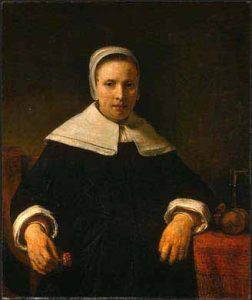Introduction to Anne Bradstreet by McKenna Sheehy
Anne Bradstreet (1612-1672)
by McKenna Sheehy
Anne Bradstreet’s life began in 1612 in what’s believed to be Northampton, England. Her Father Thomas Dudley was quite well off in position as a steward of the Earl of Lincoln and as a result of that Bradstreet had a cultured upbringing. She also received a very impressive education from her father. Anne was tutored in history and literature in Greek, Latin, French, Hebrew and of course English. From the age of six until she was around sixteen she lived at Sempringham in Lincolnshire and has access to the earl of Lincoln’s impressive library which she took full advantage of. At the age of sixteen, Anne married Simon Bradstreet, who was a Cambridge graduate and had assisted her father with the management of the Earl’s estate, and she remained married to him until her death. In 1630 the Bradstreet’s and Anne’s parents immigrated to the new world with a group of puritans lead by John Winthrop. The voyage lasted 3 months and was incredibly taxing, finally resulting in them settling in the Massachusetts Bay Colony.

Adjusting to the new world with its harsh conditions and unforeseen challenges was difficult for Anne and she was incredibly homesick, missing life in England and the beautiful estate she grew up on. In her poem “Dialogue Between Old England and New” she conveys her love for England and her disappointment in the loss caused by the social and religious turmoil that caused the Puritans to
travel to New England. During this time the new world was an incredibly dangerous place, in 1630 between April and December alone more than two hundred of the one thousand immigrants died. Though things were not easy for an immigrant to the new world at this time Anne and her family managed to do very well. Her life in Massachusetts was demanding, she raised 8 children and had the responsibilities of being the wife of a man who traveled in the highest circles of Massachusetts society.
Though her domestic responsibilities kept her incredibly busy she managed to find time to write poetry. Anne’s early poetry is conventional and imitative and widely considered unexceptional but her later work is much more personal and has won critical acceptance in the 20th century. Her book “The Tenth Muse” was her first published poetry and was actually published in 1650 without her knowledge or consent, her brother in law admired her work and took it to be published in England. In 1678 the second edition of “The Tenth Muse” was published in Boston and contains her corrections and several new, much-improved poems. Her poetry touches on the struggles she had with her faith as a puritan and a woman, as well as many other topics that would have been considered too complex for a woman at the time. Such topics included sin, redemption, immortality, death and the emotional conflicts between the pleasures of life on earth and the promise of heaven. Anne died on September 16, 1672, in Andover, Massachusetts Bay Colony at the age of 60. She is now considered to be one of the first American poets and her work is incredibly significant as not only a historical reference but also a beautiful example of well-written poetry.
Questions:
1. How did Anne Bradstreet’s religious beliefs translate into her poetry? How does her poetry
give readers now a historical look into life as a puritan woman in the early 1600s?
2. Would you consider Anne Bradstreet’s work to be feministic? Why or why not?
Text included with the permission of the author (2018)

